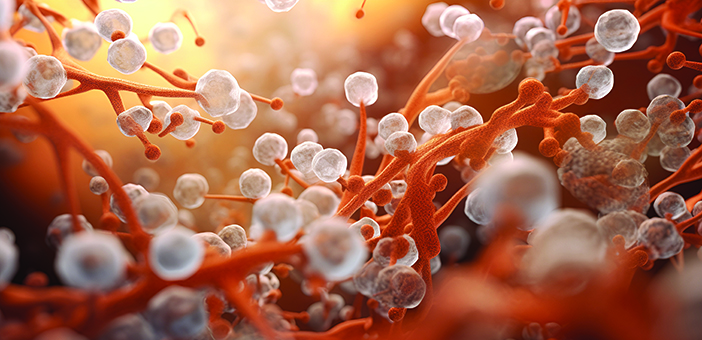New research into how Candida albicans colonizes the human GI tract suggests ways to treat difficult infections.
A new study sheds light on a fungal pathogen and how it colonizes the human gastrointestinal tract—and offers clues on how to potentially treat certain fungal infections.
The research focused on Candida albicans, a naturally occurring fungus in the human gastrointestinal tract, and the role of its secreted toxin, candidalysin, in promoting the fungus’ colonization of the gut. C. albicans is linked to bloodstream infections that have high mortality rates and can be challenging to treat, says senior author Richard Bennett, PhD, chair of molecular microbiology and immunology at Brown.
“C. albicans can escape the gut, and then disseminate throughout the body, infecting many different human organs—even the brain,” he says.
Co-author Shipra Vaishnava, PhD, associate professor of molecular microbiology and immunology, adds that fungi usually help our immune system, as they are a natural part of our body’s microorganisms acquired early in life. However, this isn’t true for all species.
“Some Candida species, including C. albicans, can cause serious infections in people with weakened immune systems,” she says. “Understanding how C. albicans thrives in the gut is crucial, especially when fungi coexist with many bacteria.”
Bennett says scientists have long known that C. albicans can grow both as single-celled yeast and as multicellular hyphae. Previous studies had shown that the yeast forms were the best at colonization, and hyphal forms less so, but most of these studies used mice given antibiotics to clear out competing bacteria and help the fungi to colonize the gut.
In the new study, published in Nature on March 6, Bennett’s lab evaluated fungal colonization in the presence of bacteria in mouse models, either by avoiding the use of antibiotics in mice naturally colonized with bacteria; using germ-free mice that were subsequently colonized with bacteria; or using antibiotic-resistant bacteria to colonize mice given antibiotics.
“If the gut is the natural niche where Candida grows as both yeast and filamentous cells, why does it bother to filament at all given that the yeast state appears to provide a fitness advantage for this niche?” says Bennett, who is also the Charles A. and Helen B. Stuart Professor of Molecular Microbiology and Immunology.
Previous studies established that the yeast-to-hyphal transition is critical for Candida to cause disease, Bennett says, and that the hyphal form secretes candidalysin, which enables it to damage and invade host cells. However, while hyphal formation and toxin production were known to be required for virulence, their roles in Candida colonization were not recognized.
“Every time bacteria were present in the gastrointestinal tract, and if the Candida cells were locked into the yeast state, they would be outcompeted by wild-type Candida cells that could filament,” Bennett says. “Our results highlight that Candida needs the ability to switch back and forth between yeast and filamentous states to colonize a mouse gut when normal levels of bacteria are present.”
Bennett says the findings explain why the fungus operates in these different morphological states; both yeast and hyphal forms are critical for Candida to colonize its natural niche.
“If you read the current literature, it states that the yeast form of C. albicans is the optimal colonization form, but much of this is based on hosts given antibiotic treatment,” Bennett says. “Our data is changing that narrative and shows that yeast-locked forms only win if bacterial levels are depleted. As soon as you have high levels of bacteria present, Candida will utilize both yeast and hyphae forms to be able to efficiently colonize the gut.”
Bennett says there hadn’t been an examination of the role of candidalysin in colonization or evidence that it provides C. albicans an advantage to colonize the gut. Additional experiments that his lab did in tandem with the lab of Bernhard Hube at Leibniz-HKI in Germany revealed that candidalysin exhibited anti-bacterial properties, which enables the hyphal form to compete with other bacteria in the gastrointestinal tract.
“We propose that there’s a direct effect of the fungal toxin on restricting the commensal bacterial species,” Bennett says.
Their data suggest that by blocking the ability of C. albicans to form hyphae, its colonization could also be reduced. Colonization is linked to gut inflammation as well as disease, as systemic infections can arise when fungal cells escape the gut. If C. albicans could be eliminated or reduced in the gut, then such treatments could block that cycle of infection.
“Even if you receive treatment with antifungal drugs, then a bloodstream infection can result in mortality rates that can approach 40 percent,” Bennett says.
He says his team wants to more closely study the interplay between gut fungus, bacteria, and the effect on the host. There are other Candida species colonizing the gut, and it’s important to understand the mechanisms behind each of their forms.
“We have a lot to do,” Bennett says, “but we are excited to get started on the next study.”
Other Brown researchers involved with this study were Shipra Vaishnava, Peter Belenky, Shen-Huan Liang, Shabnam Sircaik, Pallavi Kakade, and Corey Frazer. Researchers from New York University School of Medicine, Leibniz Institute for Natural Product Research and Infection Biology at the Hans Knoell Institute, McGovern Medical School at the University of Texas Health Science Center at Houston, Friedrich Schiller University Jena, and the Université Paris Cité also contributed.
This research was supported in part by grants from the NIH (AI166869, AI141893, AI081704 and AI168222).




